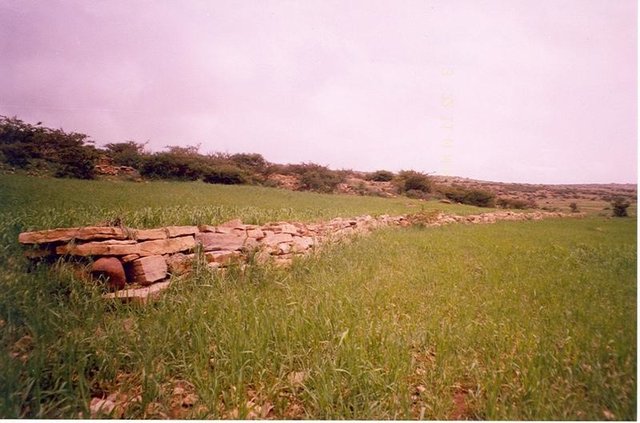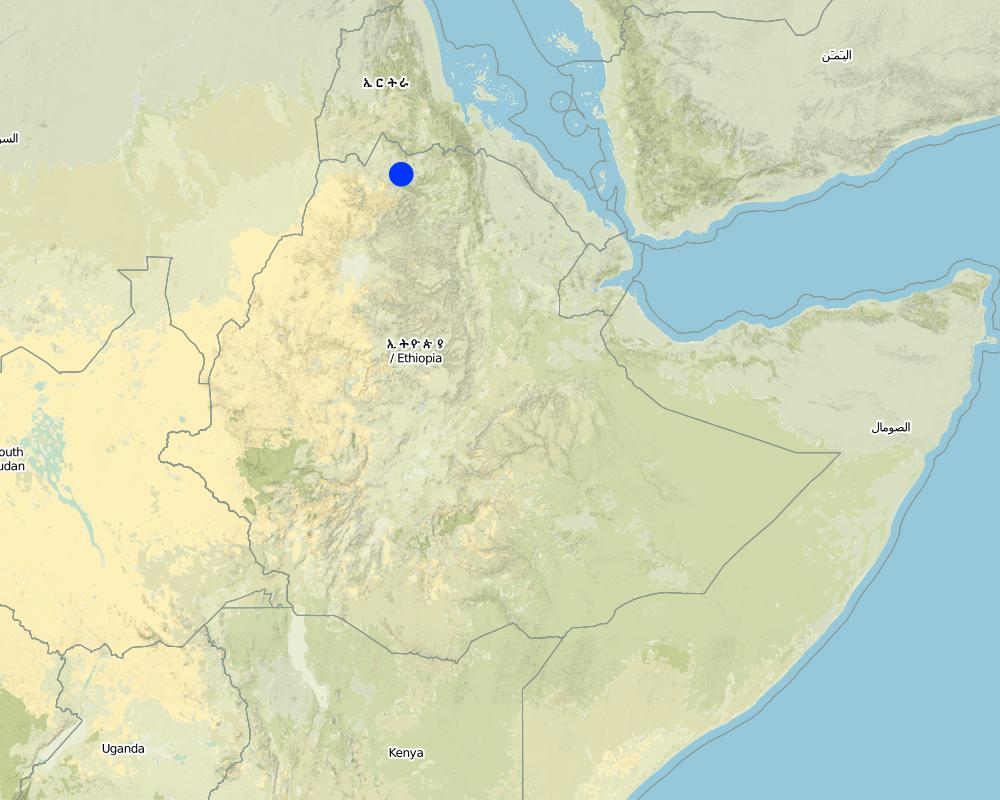Mass mobilization [埃塞俄比亚]
- 创建:
- 更新:
- 编制者: Unknown User
- 编辑者: –
- 审查者: Fabian Ottiger
approaches_2376 - 埃塞俄比亚
查看章节
全部展开 全部收起1. 一般信息
1.2 参与方法评估和文件编制的资源人员和机构的联系方式
关键资源人员
SLM专业人员:
Wolde Gabriel
Tigray Bureau of Agriculture
Mekele
埃塞俄比亚
1.3 关于使用通过WOCAT记录的数据的条件
编制者和关键资源人员接受有关使用通过WOCAT记录数据的条件。:
是
1.4 SLM技术问卷的参考

Stone bund of Tigray [埃塞俄比亚]
an allignment of stone along the contour line which stabilzes with grass species
- 编制者: Unknown User
2. SLM方法的描述
2.1 该方法的简要说明
Mass Mobilization is an approach pursued to implement SLM technologies by organizing land users to undertake SLM activities without incentives being involved.
2.2 该方法的详细说明
该方法的详细说明:
Aims / objectives: It involves the process of mobilizing and organizing land users in the community (men, women, and youth) who are able-bodied to participate in SLM activities. Land users participating in mass mobilization are required to form SLM groups. Plan for SLM is made at the woreda level and then distributed to kebeles and or sometimes each kebele proposes plan, which is later approved by the woreda. Each member contributes free labor of 20 days every year to undertake land management technologies (past) and this contribution is increased to account for 40 days a year since 2009. The specific objective is to make land users participate in the management of land by implementing improved technologies. SLM measures control runoff and enhance rainfall water percolation. The approach involves organizing land users in SLM groups. Recently two groups are formed known as development team and a sub group called a work team. A development team group comprises 20-30 members while the work team group is 10-15 members. Women and men participate equally in the work groups and in leading the team. Activities undertaken by mass mobilization are mostly (80%) carried out on cultivated lands. Every day the group evaluates its activities. They also participate on the discussions of the plan.
Methods: There is a leader for each group and a production cadre for the groups at Kushet level (the lower administrative unit) who supervises activities of the groups. The groups also work on activities other than SLM. Problems addressed include: soil erosion, deforestation, declining productivity of land, low fertility of soil, low level of participation of the community in SLM activities. All land users in the community are expected to participate in the implementation of the technologies through the mass mobilization approach. The approach area is defined by administrative and as well as watershed boundaries. The Kebele and woreda administrators, woreda specialists and development agents coordinate the implementation and planning of the approach.
2.5 采用该方法的国家/地区/地点
国家:
埃塞俄比亚
区域/州/省:
Laelay Adet, Tahtay A det, Naedir
有关地点的进一步说明:
Tigray, Ethiopia
Map
×2.6 该方法的开始和终止日期
注明开始年份:
1992
2.7 方法的类型
- 传统/本土
2.8 该方法的主要目的/目标
The Approach focused mainly on SLM with other activities (Pond & dam construction and other water harvesting technologies.)
Aware, organize and initiate land users to participate in SLM activities that aim at controlling soil erosion, which causes land degradation and encouraging land users to contribute free labor for implementing the SLM technologies introduced. The specific objectives are: I) promote the awareness of land users on land degradation problem and II) show the importance of SLM measures which protect cultivated lands from erosion, retain soil moisture and improve fertility of soils.
The SLM Approach addressed the following problems: Soil erosion, deforestation, low productivity low soil fertility, low participation of community in SWC activities.
2.9 推动或妨碍实施本办法所适用的技术的条件
社会/文化/宗教规范和价值观
- 阻碍
Many holidays are celebrated, and land users do not work on those days.
Treatment through the SLM Approach: Create awareness to work on those days.
财务资源和服务的可用性/可得性
- 阻碍
Low income of the community
Treatment through the SLM Approach: Create other off farm activities
法律框架(土地使用权、土地和水使用权)
- 启动
The existing land ownership, land use rights / water rights moderately helped the approach implementation: There is use right of land users.
了解SLM,获得技术支持
- 阻碍
Widely spaced bunds do not control inter bund erosion.
Treatment through the SLM Approach: Training to be provided and also promote awareness.
3. 相关利益相关者的参与和角色
3.1 该方法涉及的利益相关者及其职责
- 当地土地使用者/当地社区
Tabias
Working land users were work equally divided between men and women. All community member participate equally in decision making.
- 国家政府(规划者、决策者)
BOA & Regional Adminstration
- 国际组织
3.2 当地土地使用者/当地社区参与该方法的不同阶段
| 当地土地使用者/当地社区的参与 | 指定参与人员并描述活动 | |
|---|---|---|
| 启动/动机 | 被动 | public meetings: general assembly meeting called for awareness creation and informing about the development plan. |
| 计划 | 被动 | Training: train SLM commission members. They plan the activities which is later endorsed by the general assembly. |
| 实施 | 互动 | Free labour: 20 days per year |
| 监测/评估 | 被动 | Measurements observation reporting: each activity is measured by the team leader and the other committee members. |
| Research | 无 |
3.4 有关SLM技术选择的决策
具体说明谁有权决定选择要实施的技术:
- 主要是SLM专家,咨询土地使用者之后
解释:
Decisions on the method of implementing the SLM Technology were made by mainly by SLM specialists with consultation of land users
4. 技术支持、能力建设和知识管理
4.1 能力建设/培训
是否为土地使用者/其他利益相关者提供培训?:
是
明确受训人员:
- 土地使用者
- SWC specialists, extensionists/trainers (1), politicians/decision makers (2)
培训形式:
- 在职
- 农民对农民
- 示范区域
- 课程
涵盖的主题:
On desing, layout & construction methods of SWC technologies, moisture harvesting techniques.
4.2 咨询服务
土地使用者有权使用咨询服务吗?:
是
指明是否提供了咨询服务:
- 在土地使用者的土地上
说明/注释:
Name of method used for advisory service: House hold pack (PADET); Key elements: DA, Contact farmer; 1) Advisory service was carried out through: government's existing extension system; Extension staff: mainly government employees 2) Target groups for extension: land users, technicians/SWC specialists; Activities: Contrubuting free labour; Training, supervising, monitoring & evaluation, creating awarness in the co
Advisory service is quite adequate to ensure the continuation of land conservation activities
4.3 机构强化(组织发展)
是否通过这种方法建立或加强了机构?:
- 是,适度
具体说明机构的强化或建立程度:
- 本地
具体说明支持类型:
- 能力建设/培训
- 设备
4.4 监测和评估
监测和评估是该方法的一部分吗?:
是
注释:
bio-physical aspects were ad hoc monitored through measurements; indicators: soil depth, change in land use and land cover
technical aspects were regular monitored through measurements; indicators: dimensions and quality
economic / production aspects were ad hoc monitored through measurements; indicators: increase in production per unit area
area treated aspects were regular monitored through measurements; indicators: extent of work done
no. of land users involved aspects were regular monitored through measurements; indicators: number of participating land users in the work
management of Approach aspects were regular monitored through observations; indicators: impacts and changes
There were few changes in the Approach as a result of monitoring and evaluation: At initial stage of the implementation of the approach the cummunity members were contributing their free labour 3 month per year for SWC activities, but through evaluation it has been changed to 20 days/year.
5. 融资和外部物质支持
5.1 该方法中SLM组成部分的年度预算
如果不知道准确的年度预算,请给出一个范围:
- 2,000-10,000
注释(例如主要的资助来源/主要捐助者):
Approach costs were met by the following donors: government (Training and work tools support): 5.0%; local community / land user(s) (Labor and material): 95.0%
5.2 为土地使用者提供财政/物质支援
土地使用者是否获得实施该技术的财政/物质支持?:
是
5.3 对特定投入的补贴(包括劳动力)
- 设备
| 具体说明哪些投入得到了补贴 | 程度如何 | 对补贴做出具体说明 |
|---|---|---|
| 工具 | 部分融资 | |
- 农业
| 具体说明哪些投入得到了补贴 | 程度如何 | 对补贴做出具体说明 |
|---|---|---|
| 种子 | 部分融资 | |
- 基建
| 具体说明哪些投入得到了补贴 | 程度如何 | 对补贴做出具体说明 |
|---|---|---|
| Community infrastructure | 充分融资 | |
如果土地使用者的劳动力是一项重要的投入,那么是不是:
- 自愿
5.4 信用
是否根据SLM活动的方法给予信用值?:
否
6. 影响分析和结论性陈述
6.1 方法的影响
该方法是否帮助土地使用者实施和维护SLM技术?:
- 否
- 是,很少
- 是,中等
- 是,支持力度很大
To conserve their individual land by them selves.
Did other land users / projects adopt the Approach?
- 否
- 是,很少
- 是,中等
- 是,支持力度很大
In some jfood for jwork & chas for work SWC activities they apply this approach to contribute some perventage of the activities as a free labour.
6.3 方法活动的可持续性
土地使用者能否维持通过该方法实施的措施(无外部支持的情况下)?:
- 是
6.4 该方法的长处/优点
| 编制者或其他关键资源人员认为的长处/优势/机会 |
|---|
| Wokring in group improves the management of large area of cultivated lands in short period (How to sustain/ enhance this strength: More training, awareness and study tour opportunities to be provided. Provision of hand tools.) |
| Easy transfer of technology possible |
6.5 该方法的弱点/缺点以及克服它们的方法
| 编制者或其他关键资源人员认为的弱点/缺点/风险 | 如何克服它们? |
|---|---|
| Unwillingness from some land users to work in groups | Convincing land users. |
7. 参考和链接
7.1 方法/信息来源
- 实地考察、实地调查
- 与土地使用者的访谈
链接和模块
全部展开 全部收起链接

Stone bund of Tigray [埃塞俄比亚]
an allignment of stone along the contour line which stabilzes with grass species
- 编制者: Unknown User
模块
无模块


